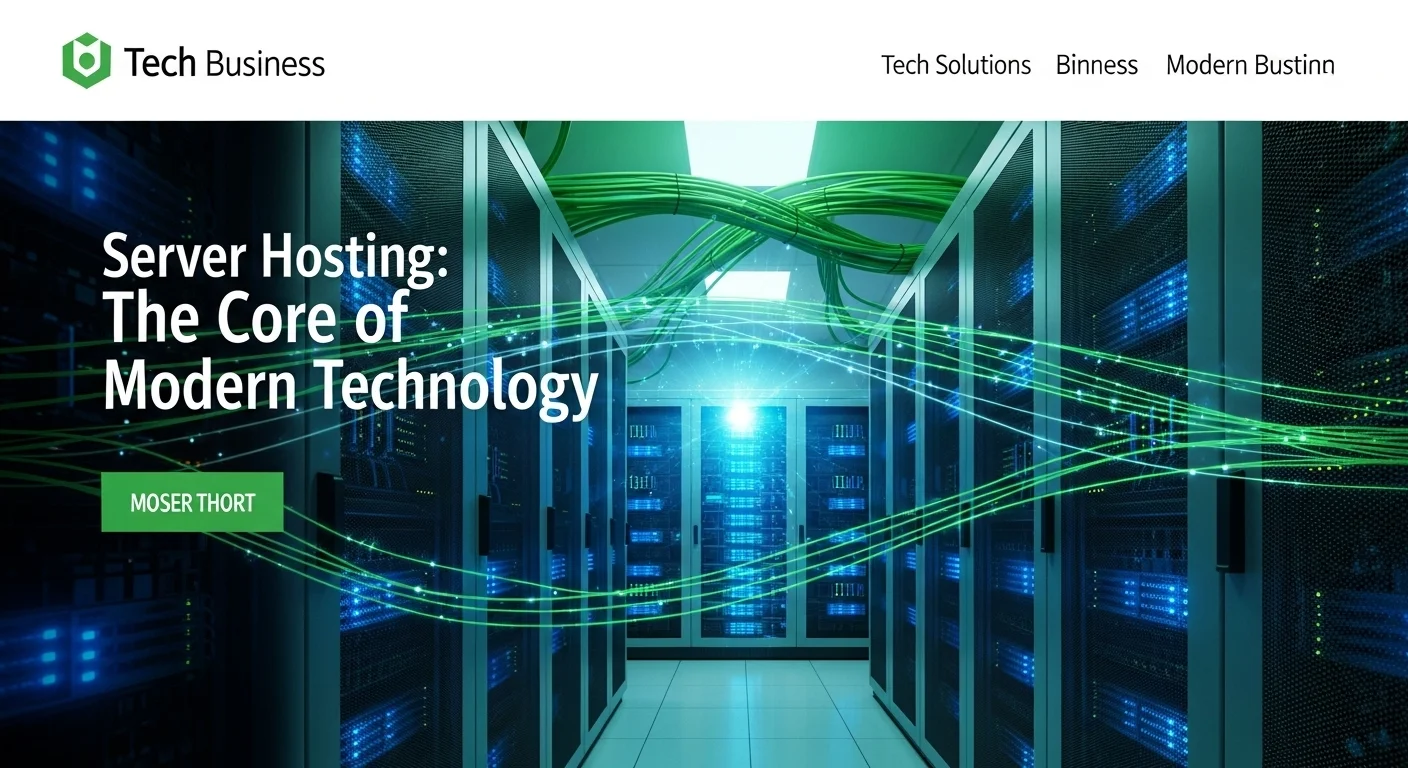Server Hosting: The Core of Modern Technology

Executive Summary
In the digital age, server hosting stands as the fundamental pillar supporting virtually every online service, application, and business. This article provides a comprehensive exploration of server hosting technology, charting its evolution from traditional on-premise setups to the dynamic world of cloud computing. We delve into the critical role hosting plays for businesses, enabling everything from e-commerce platforms to complex data analytics. Understanding the different types of hosting—Shared, VPS, Dedicated, and Cloud—is crucial for making informed decisions. Special focus is given to the industry giants, Amazon Web Services (AWS) and Google Cloud, detailing how their cloud-based server hosting solutions offer unprecedented scalability, security, and performance. For any business or technology enthusiast looking to navigate the complexities of the digital landscape, a deep understanding of server hosting is not just beneficial, it's essential for innovation and growth. This guide will equip you with the knowledge to select and manage the perfect hosting solution for your needs.
Table of Contents
What is Server Hosting and why is it important in Technology?
Server hosting is a service that provides the necessary infrastructure for businesses and individuals to make their websites, applications, and data accessible on the internet. [19] At its core, it involves renting space and resources on a server, which is a powerful computer designed to process requests and deliver data to other computers over a network. [46] Think of it as renting a plot of land to build a house; instead of a physical plot, you're renting digital space to build your online presence. This service is typically offered by a provider who manages the hardware, connectivity, and maintenance, allowing clients to focus on their core operations without the significant capital expenditure and technical burden of owning and managing their own server hardware. [2] The provider ensures the server is running 24/7, connected to a high-speed network, and secure from physical and digital threats. [38]
The Evolution from On-Premise to the Cloud
The journey of server hosting has been one of remarkable transformation. Initially, businesses had little choice but to purchase, house, and maintain their own physical servers on their premises, a model known as on-premise hosting. This required substantial investment in hardware, a dedicated IT team for maintenance, and physical space with adequate power and cooling. [1] While offering complete control, this approach was costly, complex, and slow to scale.
The first major shift came with the introduction of various off-site hosting models. These models, offered by data centers, allowed businesses to rent server resources, freeing them from the direct management of physical hardware. Let's explore the primary types that emerged:
- Shared Hosting: This is the most basic and cost-effective form of hosting. [1] Multiple websites share the resources of a single physical server. [19] It's an excellent starting point for small blogs, personal websites, and businesses with low traffic. [6] However, the shared nature means resources are limited, and a surge in traffic or resource consumption by one website (a 'noisy neighbor') can negatively impact the performance of others on the same server. [1]
- VPS (Virtual Private Server) Hosting: A significant step up from shared hosting, VPS uses virtualization technology to partition a single physical server into multiple, isolated virtual servers. [2] Each VPS acts as an independent server with its own dedicated resources (CPU, RAM) and operating system. [17] This provides more control, better performance, and enhanced security compared to shared hosting, making it ideal for medium-sized businesses and websites that have outgrown the limitations of shared plans. [30]
- Dedicated Server Hosting: In this model, a client rents an entire physical server exclusively for their own use. [2] This offers the highest level of performance, control, and security, as all server resources are dedicated to a single tenant. [19] Large enterprises, high-traffic e-commerce sites, and applications with stringent compliance requirements often opt for dedicated hosting. [6] The primary drawbacks are its higher cost and the need for significant technical expertise to manage the server. [2]
The Dawn of Cloud Hosting: A Paradigm Shift
The most profound evolution in server hosting has been the rise of cloud based server hosting. Unlike traditional models that rely on a single physical server, cloud hosting utilizes a vast network of interconnected virtual and physical servers. [27] This distributed infrastructure fundamentally changes how resources are provisioned and consumed. When you use a cloud hosting server, you are not tied to a single machine; you are tapping into a massive pool of computing resources. [3] This model is the backbone of modern technology, powering everything from streaming services and social media platforms to complex AI and big data applications.
The pioneers and leaders in this space are technology giants, with amazon cloud server hosting (more commonly known as aws cloud server hosting) and google cloud server hosting at the forefront. [40] These platforms, known as Infrastructure as a Service (IaaS), provide on-demand computing resources over the internet, typically on a pay-as-you-go basis. [5] This means businesses can access immense computing power without any upfront hardware investment and only pay for the resources they actually consume, offering unparalleled flexibility and cost-efficiency. [27]
The Critical Importance of Server Hosting in Modern Technology
In today's interconnected world, server hosting is not just a technical requirement; it's a strategic business asset. Its importance can be understood through several key benefits:
- The Foundation of the Digital Economy: Every online business, from a small e-commerce store to a global SaaS enterprise, relies on server hosting to deliver its services. Without a reliable hosting solution, a business is invisible and inaccessible to its customers online.
- Enabling Scalability and Growth: For startups and growing businesses, the ability to scale resources up or down on demand is critical. [38] A cloud based server hosting solution allows a company to handle sudden traffic spikes during a marketing campaign and then scale back down to reduce costs, a feat that is difficult and expensive with traditional hosting. [6, 18]
- Performance and User Experience (UX): Website and application performance directly impacts user satisfaction and business outcomes. Slow loading times can lead to high bounce rates and lost revenue. Quality hosting ensures fast data delivery, high availability (uptime), and a smooth user experience, which are crucial for retaining customers and maintaining a positive brand reputation. [8]
- Security and Compliance: In an era of increasing cyber threats, robust security is non-negotiable. [10] Hosting providers invest heavily in physical and digital security measures, including firewalls, DDoS protection, and regular monitoring, to protect client data. [38] For businesses in regulated industries like healthcare or finance, specialized hosting solutions from providers like amazon cloud server hosting and google cloud server hosting offer compliance with standards such as HIPAA and PCI-DSS. [10]
- Cost-Effectiveness and Resource Optimization: Server hosting, particularly the cloud model, converts a large capital expense (CapEx) into a predictable operational expense (OpEx). [1] Businesses avoid the costs associated with hardware purchase, maintenance, power, and cooling. The pay-as-you-go model of a cloud hosting server ensures that companies don't pay for idle resources, leading to significant cost savings. [23]
- Global Reach and Low Latency: Major cloud providers like AWS and Google Cloud have data centers located all over the world. [40] This allows businesses to deploy their applications closer to their end-users, reducing latency and improving performance on a global scale. This is a key advantage of using a platform like google cloud server hosting, which leverages Google's vast private fiber network. [15]
In conclusion, server hosting has evolved from a simple necessity for publishing a webpage into a complex and powerful technological foundation. It is the engine that drives digital innovation, business agility, and global connectivity. Understanding the differences between hosting types and recognizing the transformative power of aws cloud server hosting and its competitors is the first step for any organization looking to thrive in the digital-first era. The choice of a hosting solution is one of the most critical technology decisions a business will make, impacting its performance, security, and ability to grow for years to come.

Complete guide to Server Hosting in Technology and Business Solutions
Choosing the right server hosting solution is a pivotal decision for any business, influencing everything from application performance and user experience to operational costs and future scalability. This guide provides a deep dive into the technical methods and business strategies involved in selecting and implementing the ideal hosting environment, with a particular focus on the dominant forces in the market: cloud based server hosting platforms.
A Deeper Dive into Cloud Hosting Architecture
To make an informed decision, it's essential to understand the technology that powers the cloud. Unlike traditional hosting tied to a single server, cloud hosting operates on the principles of virtualization and resource pooling. A hypervisor, which is a specialized software, creates and runs virtual machines (VMs). These VMs are then distributed across a network of physical servers. This abstraction of hardware is what makes a cloud hosting server so flexible. Resources like CPU, RAM, and storage are pooled together and can be allocated dynamically to different VMs as needed. This architecture provides several key advantages:
- On-Demand Self-Service: Users can provision computing resources automatically without requiring human interaction with the service provider. [1]
- Broad Network Access: Capabilities are available over the network and accessed through standard mechanisms (e.g., web browsers, APIs).
- Resource Pooling: The provider's computing resources are pooled to serve multiple consumers using a multi-tenant model, with different physical and virtual resources dynamically assigned and reassigned according to consumer demand. [1]
- Rapid Elasticity: Resources can be elastically provisioned and released, in some cases automatically, to scale rapidly outward and inward commensurate with demand. [8]
- Measured Service: Cloud systems automatically control and optimize resource use by leveraging a metering capability. Resource usage can be monitored, controlled, and reported, providing transparency for both the provider and consumer of the utilized service. [27]
Spotlight on the Titans: AWS and Google Cloud
When discussing modern hosting, the conversation inevitably turns to the hyperscale cloud providers. Amazon cloud server hosting (AWS) and google cloud server hosting (GCP) are the undisputed market leaders, each offering a vast portfolio of services that go far beyond simple server provisioning. [40]
Amazon Web Services (AWS)
Launched in 2006, AWS is the oldest and most mature player in the cloud market. Its comprehensive suite of services makes aws cloud server hosting the go-to choice for a wide range of businesses, from startups to large enterprises. [5]
- Core Compute Service: Amazon EC2 (Elastic Compute Cloud) is the heart of AWS, providing secure and resizable compute capacity in the cloud. It offers a massive selection of instance types optimized for different workloads (e.g., general purpose, compute-optimized, memory-optimized).
- Storage Solutions: Amazon S3 (Simple Storage Service) is an industry-standard object storage service known for its scalability, data availability, security, and performance. For block storage attached to EC2 instances, AWS provides EBS (Elastic Block Store).
- Database Services: AWS offers a wide array of managed database services, including Amazon RDS (Relational Database Service) which supports engines like MySQL, PostgreSQL, and SQL Server, as well as its own high-performance database, Amazon Aurora.
- Networking: Amazon VPC (Virtual Private Cloud) allows you to carve out a logically isolated section of the AWS Cloud where you can launch AWS resources in a virtual network that you define.
- Strengths: AWS's primary strengths are its market maturity, extensive global infrastructure, the broadest portfolio of services, and a massive community and knowledge base. [24]
Google Cloud Platform (GCP)
While a later entrant to the market, google cloud server hosting has rapidly gained ground by leveraging Google's world-class infrastructure and expertise in specific high-tech areas. [18]
- Core Compute Service: Google Compute Engine (GCE) provides high-performance, scalable virtual machines. GCP is known for its fast VM provisioning times and powerful global networking. [23]
- Storage Solutions: Google Cloud Storage offers unified object storage for developers and enterprises. Persistent Disk provides reliable, high-performance block storage for GCE instances.
- Database Services: Cloud SQL is a fully managed relational database service for MySQL, PostgreSQL, and SQL Server. For massive scalability, Cloud Spanner offers a unique, globally distributed relational database. [37]
- Networking and Kubernetes: GCP is highly regarded for its premium global fiber network, which can result in lower latency. It is also the birthplace of Kubernetes, and its Google Kubernetes Engine (GKE) is considered a leading managed Kubernetes service. [15]
- Strengths: GCP's key strengths lie in its top-tier networking, expertise in containers and Kubernetes, leadership in data analytics and machine learning (AI), and often more customer-friendly pricing structures, such as per-minute billing and sustained-use discounts. [37]
Technical and Business Comparison: AWS vs. GCP
Choosing between aws cloud server hosting and google cloud server hosting depends heavily on your specific needs.
| Factor | AWS | Google Cloud (GCP) |
|---|---|---|
| Market Position | Largest market share, most mature platform. [40] | Third largest, rapidly growing, strong in specific niches. [18] |
| Pricing Model | Pay-as-you-go (per-hour or per-second billing). Discounts via Savings Plans and Reserved Instances (RIs). [37] | Pay-as-you-go (per-second billing). Automatic Sustained Use Discounts (SUDs) and Committed Use Discounts (CUDs). Often perceived as more cost-effective for certain workloads. [11] |
| Compute | Amazon EC2. Huge variety of predefined instance types. | Google Compute Engine. Offers custom machine types, allowing for more granular resource allocation. [24] |
| Containers | Amazon EKS (Elastic Kubernetes Service) and ECS (Elastic Container Service). | Google Kubernetes Engine (GKE). Widely considered the industry-leading managed Kubernetes service. |
| Data & Analytics | Broad set of services (Redshift, EMR, Athena). | A key strength. BigQuery is a powerful, serverless data warehouse. Strong AI/ML platform. [37] |
| Global Network | Extensive global footprint. | Leverages Google's private global fiber network, which can offer performance advantages. [15] |
Business Strategy: How to Choose Your Hosting Solution
Selecting the right hosting is not just a technical task but a strategic business decision. Follow these steps to ensure you make the right choice:
- Assess Your Technical and Business Requirements: Before looking at providers, look at your own needs. [35] What are your expected traffic levels? What are your storage and database requirements? Do you need to comply with specific regulations like GDPR or HIPAA? What is your budget? What is the technical skill level of your team?
- Plan for Scalability: Your business will hopefully grow. Your hosting solution must be able to grow with you. [35] A cloud based server hosting solution is inherently scalable, but you need to understand how the provider handles it. Does it offer auto-scaling? How quickly can new resources be provisioned? [18]
- Evaluate Security and Compliance: Security is paramount. [10] Investigate the provider's security measures, including physical data center security, network security (firewalls, DDoS mitigation), and data encryption. [35] If you operate in a regulated industry, ensure the provider offers compliance certifications for your specific needs.
- Analyze Pricing and Total Cost of Ownership (TCO): Don't just look at the sticker price. Understand the pricing model completely. [33] While a cloud hosting server offers pay-as-you-go pricing, costs can become complex. Factor in data transfer fees (egress costs), storage costs, and charges for additional services like load balancers and premium support. [29] Use the providers' own TCO calculators to estimate your long-term expenses.
- Consider Managed vs. Unmanaged Services: In an unmanaged environment, you are responsible for all software installation, configuration, and maintenance. In a managed hosting plan, the provider handles these tasks for you. [38] Managed services cost more but can free up your IT team to focus on strategic initiatives, which is especially valuable for businesses without a large, dedicated IT staff.
In conclusion, the modern technology landscape is dominated by powerful and flexible cloud hosting solutions. By understanding the underlying technology of a cloud hosting server and carefully comparing the offerings of major players like amazon cloud server hosting and google cloud server hosting, businesses can make a strategic choice. This decision should be guided by a thorough assessment of current needs, future growth plans, and the total cost of ownership, ensuring the selected platform can serve as a robust and scalable foundation for success.

Tips and strategies for Server Hosting to improve your Technology experience
Once you've selected and deployed a server hosting solution, the journey doesn't end. Effective management and optimization are crucial for ensuring security, maintaining high performance, controlling costs, and ultimately, improving your overall technology experience. This section provides actionable tips and strategies, with a focus on leveraging the advanced capabilities of modern cloud based server hosting platforms like those offered by Amazon and Google.
Core Best Practices for Server Management
Whether you're on a VPS, a dedicated server, or a sophisticated cloud setup, these fundamental practices are universally applicable and form the bedrock of a healthy hosting environment.
- Security Hardening: Security is an ongoing process, not a one-time setup. [12] Implement a multi-layered security strategy. This includes configuring firewalls to control inbound and outbound traffic, regularly applying security patches to the operating system and all installed software to protect against known vulnerabilities, and implementing strong access control using Identity and Access Management (IAM) policies. [44] Regularly conduct vulnerability scans and use tools to monitor for intrusions. Both amazon cloud server hosting (with AWS Shield) and google cloud server hosting (with Google Cloud Armor) provide robust tools for DDoS mitigation and threat detection. [23]
- Performance Optimization: A slow application can drive users away. Continuously monitor your server's performance metrics, such as CPU utilization, memory usage, and disk I/O. [7] To enhance speed, implement caching at various levels. A Content Delivery Network (CDN), like Amazon CloudFront or Google Cloud CDN, caches your static content at edge locations around the world, delivering it to users from a nearby server to reduce latency. [23] Also, consider object caching for your application and database query caching to speed up dynamic content delivery. For applications with high traffic, use a load balancer to distribute requests across multiple servers, preventing any single server from becoming a bottleneck. [7]
- Comprehensive Monitoring and Alerting: You can't fix what you can't see. Set up robust monitoring for your entire infrastructure. [12] Services like Amazon CloudWatch and Google Cloud Monitoring provide detailed insights into resource utilization, application performance, and operational health. Configure alerts to be automatically notified via email or SMS when certain thresholds are breached (e.g., CPU usage exceeds 80% for 5 minutes). This proactive approach allows you to address potential issues before they escalate into outages. [7]
- Reliable Backup and Disaster Recovery (DR): Data loss can be catastrophic. Implement an automated backup strategy that is regular and consistent. [12] Cloud platforms make this easy with features like EBS snapshots in AWS and Persistent Disk snapshots in GCP. Store your backups in a separate, secure location, preferably in a different geographic region. [44] Test your recovery process periodically to ensure you can restore your data quickly and effectively in the event of a failure. For mission-critical applications, design a disaster recovery plan that may involve a hot-standby or multi-region active-active architecture.
Advanced Strategies for Cloud Cost Optimization
The flexibility of a cloud hosting server is a double-edged sword; if not managed carefully, costs can spiral out of control. [36] Employ these strategies to maximize your return on investment.
- Right-Sizing Resources: This is the most effective cost-saving measure. [4] Many organizations overprovision resources 'just in case,' leading to significant waste. Use monitoring data to analyze the actual resource consumption of your instances over time and downsize them to a more appropriate (and cheaper) type. [36]
- Leverage Provider-Specific Pricing Models: For workloads with predictable usage, commit to a 1- or 3-year term using AWS Savings Plans/Reserved Instances or GCP's Committed Use Discounts to receive discounts of up to 70% compared to on-demand prices. [34] For fault-tolerant and non-urgent workloads like batch processing or data analysis, use Spot Instances (AWS) or Preemptible VMs (GCP), which offer massive discounts on spare compute capacity. [9]
- Automate Shutdowns: Don't let development, testing, or staging environments run 24/7 if they are only used during business hours. Create automated scripts or use built-in services to shut down these non-production instances during evenings and weekends, potentially cutting their costs by over 60%. [34]
- Optimize Data Storage and Transfer: Storage costs can be subtle but significant. Implement a data lifecycle policy to automatically move infrequently accessed data to cheaper storage tiers, such as Amazon S3 Glacier or Google Cloud Archive Storage. [9] Be mindful of data egress fees—the cost of moving data out of the cloud. [29] Where possible, architect your applications to minimize data transfer between regions or out to the internet.
Leveraging Next-Generation Cloud Technologies
To truly enhance your technology experience, go beyond basic virtual machines and embrace the more advanced services offered by platforms like aws cloud server hosting and its competitors.
- Serverless Computing: Services like AWS Lambda and Google Cloud Functions allow you to run code without provisioning or managing any servers at all. [31] This is ideal for event-driven applications, such as processing an image upload or running a scheduled task. You pay only for the compute time you consume down to the millisecond, making it incredibly cost-effective for intermittent workloads.
- Containers and Orchestration: Containerization with Docker packages an application and its dependencies into a standardized unit for software development. Orchestration platforms like Kubernetes then automate the deployment, scaling, and management of these containers. Using a managed service like Amazon EKS or the industry-leading google cloud server hosting's GKE simplifies the immense complexity of running Kubernetes, allowing you to build highly scalable and resilient microservices-based applications.
- Infrastructure as Code (IaC): Tools like Terraform and AWS CloudFormation allow you to define and manage your entire cloud infrastructure using code. This approach enables you to create consistent, repeatable environments, track changes through version control (like Git), and automate your deployment pipelines. It reduces manual errors and makes managing complex environments significantly more efficient. For a deeper understanding of architectural patterns in the cloud, resources like Martin Fowler's articles on serverless architectures provide invaluable expert insights.
In conclusion, optimizing your server hosting is a continuous cycle of monitoring, securing, and refining. By implementing fundamental best practices, diligently managing costs, and strategically adopting advanced technologies like serverless and containers, you can transform your hosting platform from a mere utility into a powerful engine for innovation. Whether you are using a simple VPS or a complex multi-cloud deployment involving amazon cloud server hosting and google cloud server hosting, these strategies will ensure your technology infrastructure is secure, performant, cost-effective, and perfectly aligned with your business goals.
Expert Reviews & Testimonials
Sarah Johnson, Business Owner ⭐⭐⭐
The information about Server Hosting is correct but I think they could add more practical examples for business owners like us.
Mike Chen, IT Consultant ⭐⭐⭐⭐
Useful article about Server Hosting. It helped me better understand the topic, although some concepts could be explained more simply.
Emma Davis, Tech Expert ⭐⭐⭐⭐⭐
Excellent article! Very comprehensive on Server Hosting. It helped me a lot for my specialization and I understood everything perfectly.



